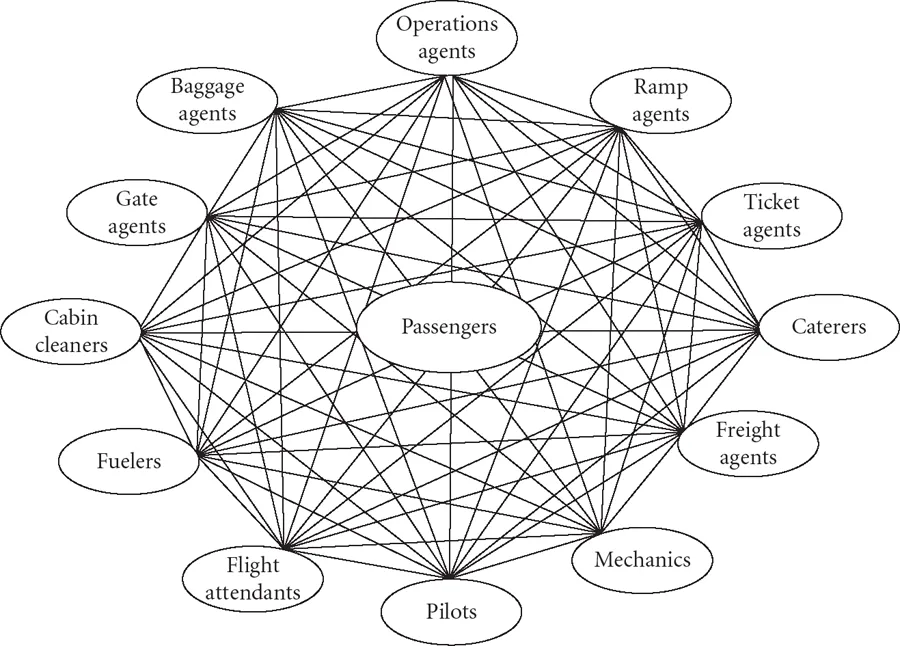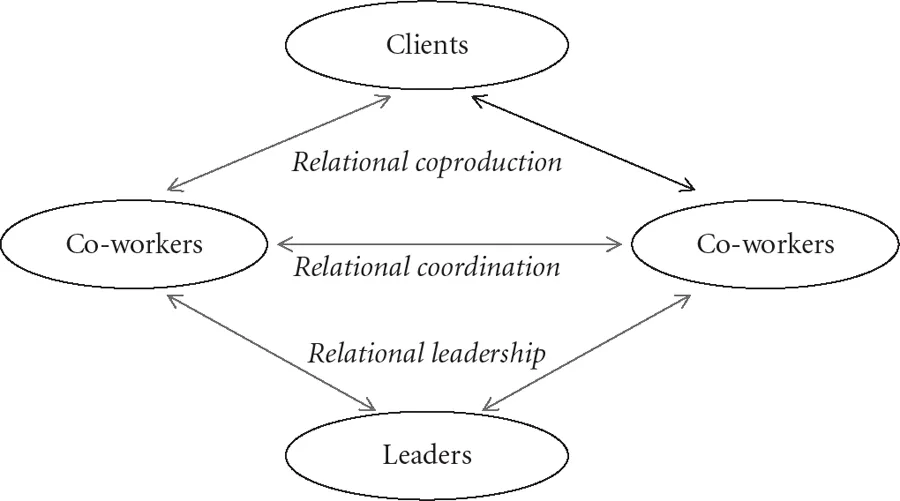![]()
PART ONE
RELATIONSHIPS AND PERFORMANCE
We begin our journey in Part I by identifying the need for a relational response to the performance pressures we face in today’s dynamic and uncertain world. When faced with these pressures, organizations often undermine quality to achieve efficiency, or undermine worker outcomes to achieve customer or shareholder outcomes. These are low-road approaches. However, evidence suggests that high-road approaches, which seek to achieve better outcomes for all parties, have been more successful in the manufacturing and service sectors. To take the high road requires a different approach—a fundamental transformation of relationships among co-workers, between workers and their customers, and between workers and their leaders.
I introduce the concept of relational coordination among co-workers, explaining how this process drives a wide range of performance outcomes, from quality and efficiency to worker and client engagement to learning and innovation. I show how these dynamics look when workers partner with their customers in a process called relational coproduction. Finally, I show how leaders support these dynamics using a process called relational leadership.
This section closes as I reveal how these three dynamics are supported—or undermined—by the organizational structures we rely on every day to get things done. The bottom line is that real change requires us not only to transform our organizational dynamics but also to redesign many of our existing support structures at work.
![]()
1
MEETING PERFORMANCE PRESSURES WITH A RELATIONAL RESPONSE
Organizations in virtually every industry are facing pressures to do more with less. Whether these pressures come from customers, supply chain partners, shareholders, policy makers, or regulators, organizations are compelled to provide better, higher quality outcomes, more rapidly and at lower costs. Although these performance pressures are now widespread, it was the manufacturing sector that faced them first, in the form of lower cost, higher quality competition from abroad. In response, manufacturers either moved operations overseas or invested domestically in smarter, more efficient methods of production through better coordination among frontline workers, their leaders, their supply partners, and their customers.1
More recently, the service sector has faced these same performance pressures, as competitive forces have loomed large in industries from airlines to banking to trucking, from food services to consulting, from engineering to legal services, and more. These industries have been forced to transform radically in many cases, choosing between low-road strategies that rely on the reduction of wages and working conditions, and high-road strategies that rely on investments in smarter, more efficient methods of delivery enabled by better coordination among key stakeholders.2
Now these performance pressures have finally penetrated the healthcare, education, and human services sectors, sectors that until recent years were somewhat protected from competition. Budgetary crises around the globe—with underlying causes that include aging populations, the growth of chronic illness, educational institutions struggling to meet changing demands, failing public infrastructures, and the natural environment under stress—have brought these performance pressures home to roost. Meanwhile, younger generations are seeking more balanced lives, with more satisfying work environments and fewer hours spent at work, so it is not likely that we will be able to solve these challenges simply by working harder and longer.
In this book, I argue that the intense performance pressures we are facing will require organizational transformations similar to those achieved earlier in the manufacturing and service sectors, but on a larger, more comprehensive scale.
CHOOSING THE HIGH ROAD
As always, when facing performance pressures, there are critical choices to be made—namely, will we pursue low-road strategies that rely primarily on the reduction of wages and the degradation of working conditions? Or will we instead pursue the high-road strategies that produce positive outcomes for a broader range of stakeholders?3 These approaches have been called many names, including mutual gains and high-road, win-win, or integrative solutions.4
One thing is clear. High-road strategies are fundamentally relational, powered by high-quality connections across key stakeholders.5 Why? High-road strategies require stakeholders to create new value and share it fairly. To do this, human capital is only half the story—it is through social capital that human capital is combined and leveraged for maximum impact.6 Thus the primary focus in this book is on relational coordination: coordinating work through high-quality communication, supported by relationships of shared goals, shared knowledge, and mutual respect. High-road strategies are fundamentally relational because the worker skills and knowledge so central to these strategies need to be connected through relationships in order to create value. Without relationships, worker skills and knowledge are like disconnected icebergs of expertise floating in the sea.
RELATIONAL COORDINATION
Relational coordination is a powerful way to connect worker skills and knowledge to create value and make high-road or win-win solutions possible. Relational coordination is simply the patterns of communicating and relating through which workers integrate their tasks into a whole. In the early 1990s, I “discovered” relational coordination while conducting research on the flight departure process, as I later documented in The Southwest Airlines Way. Airlines carry out the flight departure process hundreds of times daily, in dozens of locations. The success or failure of the flight departure process can make or break an airline’s efficiency and its reputation for reliability. Between the arrival of a plane and its next departure, a highly interdependent set of tasks is performed, in the face of uncertainty and time constraints, by workers in twelve distinct roles—pilots, flight attendants, mechanics, gate agents, ticketing agents, ramp agents, baggage transfer agents, aircraft cleaners, caterers, fuelers, freight agents, and operations agents, as illustrated in Figure 1.1.
As the airline industry became more competitive following deregulation in the late 1970s, coordinating this work process became one of the keys to competitive success. I found that efficiency and quality performance outcomes—turnaround times, employee productivity, on-time performance, customer satisfaction, baggage handling—were all powerfully influenced by the strength or weakness of relational coordination among workers.7 Since then, a wide range of quality and efficiency outcomes for relational coordination have been documented across many industries, as we will see in Chapter 2. The strength of relational coordination clearly matters for achieving performance under pressure.
BEYOND RELATIONAL COORDINATION
But the performance pressures we face today cannot be addressed by workers alone, even when they partner closely across functional, organizational, and sectoral boundaries. We also need to coordinate more closely with our customers. Customers are capable of doing important work, particularly with support from skilled workers. This is called coproduction, and we have seen evidence of this emerging trend in many industries. Consider the work that airline passengers now do without thinking twice, such as booking their own flights, and the work that banking and retail customers increasingly do, such as managing their own accounts and completing transactions without staff support, enabled by technology. Some of the most effective companies are turning work over to their customers, even connecting customers with each other to create value, whether by sharing information or creating communities of support, or both.8
When we fail to engage our customers and treat them instead as passive recipients of our expertise, we are missing an opportunity to create value and thus to respond to the very performance pressures we are facing. When we extend relationships of shared goals, shared knowledge, and mutual respect to include our customers, we are engaging in relational coproduction.
Relational coordination needs the full support of leaders as well—leaders who understand and respect the complexity of the work that their employees carry out every day. When I began to study flight departures, I interviewed Bob Baker, vice president of operations at American Airlines, who explained, “This is one of the most complex things we do every day, and most people here at headquarters don’t realize that.” Baker had risen to his leadership position having started as a ramp manager on the frontline. Many of his colleagues in top management at American lacked his deep understanding and respect for the work carried out on the ground. During CEO Robert Crandall’s tenure, that lack of respect was often reciprocated, and the gulf between top management and frontline workers grew larger, leaving many mid-level managers stranded in between.
This scenario was in stark contrast to what I found at American Airlines’ high-performing counterpart, Southwest Airlines, located next door in the same city of Dallas, Texas. At Southwest, leaders, including the CEO, tended to be highly attentive to the importance of frontline workers. A Southwest pilot explained:
Herb Kelleher is not your average CEO. He really cares to let people know he cares . . . He sets the example of respect for everyone. All are important. Treat each other with the same respect as our customers. So people are happy . . . I can call [our CEO] today . . . He listens to everybody. He’s unbelievable when it comes to personal etiquette. If you’ve got a problem, he cares.
The Southwest CEO was exhibiting relational leadership.
We will learn how all three relational dynamics—relational coordination, relational coproduction, and relational leadership—work together to drive high performance. And they are mutually supporting. Figure 1.2 shows that relational coordination among co-workers enables them to more effectively engage in relational coproduction with the clients they serve. To do so, workers must be supported by leaders who practice relational leadership, developing reciprocal relationships of shared goals, shared knowledge, and mutual respect throughout the organization. While none of these three relational dynamics are rocket science, they run counter to the bureaucratic legacy we have inherited.
GETTING FROM HERE TO THERE: A RELATIONAL MODEL OF ORGANIZATIONAL CHANGE
Pressure for change comes when our task demands change in ways that require us to engage in new relationship patterns in order to coordinate our work. Pressure for change also comes when an industry becomes more competitive, making coordination more relevant to the success or survival of the organization. In industries facing disruptive change—for example, the auto industry in the 1980s, the airline industry in the 1990s, and the healthcare industry right now—both happen simultaneously. Changing task demands call for higher levels of relational coordination, and at the same time, increased competition makes relational coordination more critical for survival. As a clinical nurse specialist pointed out, “Miscommunication between the physician and the nurse is common because so many things are happening so quickly. But because patients are in and out so quickly [due to pressure from the payers], it’s even more important to communicate well.” At the same time, a physician at a nearby hospital reflected, “The communication line wasn’t there. We thought it was, but it wasn’t. We talk to nurses every day, but we aren’t really communicating.” Down the street, at a competing health system, a physician lamented:
We’re all being held with a gun to our heads, that if you continue doing things the way we did things, we are going to be a nonentity . . . You can’t lose a million dollars a week and survive . . . And we’re frustrated . . . We don’t get the time with the patients that we once got . . . It’s not a happy place for us. But if you don’t make the changes, you’re going to be doing catering.9
We need a model of change that helps us to understand how structures and relationships ...


